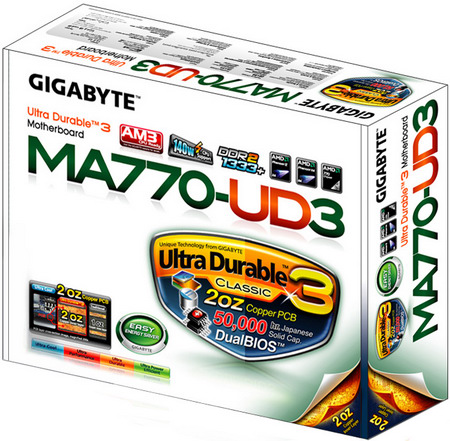Motherboards with integrated chipsets are actively competing with those with discrete counterparts in the mid-end segment as well, in addition to the low-end segment, where integrated chipsets rule. This happens primarily due to successful chipsets (AMD 780G and especially 790GX) used in many well-rigged motherboards. But motherboards with inexpensive discrete chipsets -- historical mainstream -- certainly remain popular among users, who know that they will use graphics cards. And a significant part of home users is attracted to 3D games that require powerful graphics. However, such motherboards rarely make it to reviews, because their lean functionality does not interest reviewers. Sometimes such motherboards get proprietary technologies, and in this case it would have been very strange to ignore such popular products. Today we are going to examine one of such motherboards with the AMD 770 chipset.
It has two revisions that differ only in Southbridges: the one we tested was equipped with the SB700, and the second modification is equipped with the SB710. Differences between these bridges come down to support for Advanced Clock Calibration by the newer model, which comes in handy for overclocking Phenoms with unlocked multipliers. That is, it expands the frequency potential and allows to unlock the fourth core in triple-core Phenom II processors. So if you plan to install one of the processors mentioned above, it makes sense to choose the second revision of this motherboard. Besides, Gigabyte has launched an almost exact copy of the second revision for Socket AM3 - MA770T-UD3P - that supports DDR3 memory and features a reinforced voltage regulator.
Design
This motherboard has no fads in its design, which is natural for an inexpensive product. Fortunately, there are no engineering flaws sticking out either. Only the additional CPU power connector should have been installed at the edge of the board instead of the center, so that there were no need to lay the cable over the CPU cooler. We used to consider four PCIEx1 and just two PCI slots to be a drawback. But everything is changing, and practically all kinds of expansion cards are available in the PCIE format. So two PCI slots will be enough for old cards. It must be also taken into account that a dual-slot graphics card will block one of PCIE slots, so there will be only three available slots. And if engineers had replaced one of them with PCI, there would have been only two of them left, too few.
The board has two BIOS chips installed: a primary chip and a backup one that safeguards users against flashing failures.
A motherboard with a discrete chipset from AMD, mainstream model at that, can do fine with any cooling system -- it won't overheat. In fact, we can discuss rationality of this or that technical solution only from ideological positions. From this point of view, the Northbridge heatsink looks optimal, its fins arranged perpendicular to the rear wall of the PC enclosure. The brand slate is intended to direct the air flow, so a rear-panel fan is implied. Indeed, such fans are usually installed over the panel with connectors. On the other hand, in case of chipsets that do not heat much, it's cheaper to install heatsinks that do not pretend to care about airflow directions. And the brand slate can be installed somewhere else. But this is theory. From the practical point of view, the chipset heatsink copes with its task even without a rear-panel fan and help from the CPU cooler. Perfectionists may replace the thermal grease, because heatsinks fixed with plastic latches are prone to shifts in transit and during installation, and the bundled thick grease is fragile, so the thermal contact may be damaged.

The above mentioned proprietary technology used in this motherboard is twice as thick copper layers for power and ground. It's done for even heat distribution rather than for higher currents (the thicker the conductor, the lower resistance and lower losses to heating) applied to components. Apart from providing electric connections between components, a board is an effective heat sink. Some chips transfer heat through soldered points much better than through their packages, even if they are topped with a heatsink. It's not easy to determine what this effect gives us in the nominal mode, the system is stable even without such tricks. But when the system is overclocked, this feature should contribute to high results.

The onboard voltage regulator has five phases, four of them, supplying processor cores, use three MOSFETs each. The fifth phase, responsible for CPU NB, contains two MOSFETs. The power circuit also contains 13 x 560 uF and 2 x 470 uF solid capacitors from leading Japanese manufacturers. It supports processors with TDP up to 140 W.
The motherboard comes with a minimalistic bundle, which has become a standard for mass models, and sometimes even leaks to High-End. However, two SATA cables contain metal latches and L-shaped connectors at one end.
Both features contribute to reliable connection and prevent cables from self-unplugging in transit or manipulations inside the PC enclosure. There is also a brief installation guide.
Besides, unlike poor bundles from other manufacturers, this one includes proprietary and third-party utilities. We can mention such programs as EasyTune for system monitoring, fan speed control, etc; Face-Wizard for BIOS splash screen editing; Q-Share for convenient file sharing in a local area network, and @BIOS to download the latest BIOS version at the Gigabyte server and flash it. The motherboard is not equipped with hardware technologies to control the number of active phases in the voltage regulator, and Easy Energy Saver implements software control, which is similar to the Cool'n'Quiet driver in functionality and results. It may be interesting for some of our readers to watch the amount of conserved power. However, this utility is not very stable, and it does not work correctly with any BIOS version. Third-party utilities include Norton Internet Security, Kaspersky Anti-Virus, COREL MediaOne, and Roxio Buzz.
Write a comment below. No registration needed!




